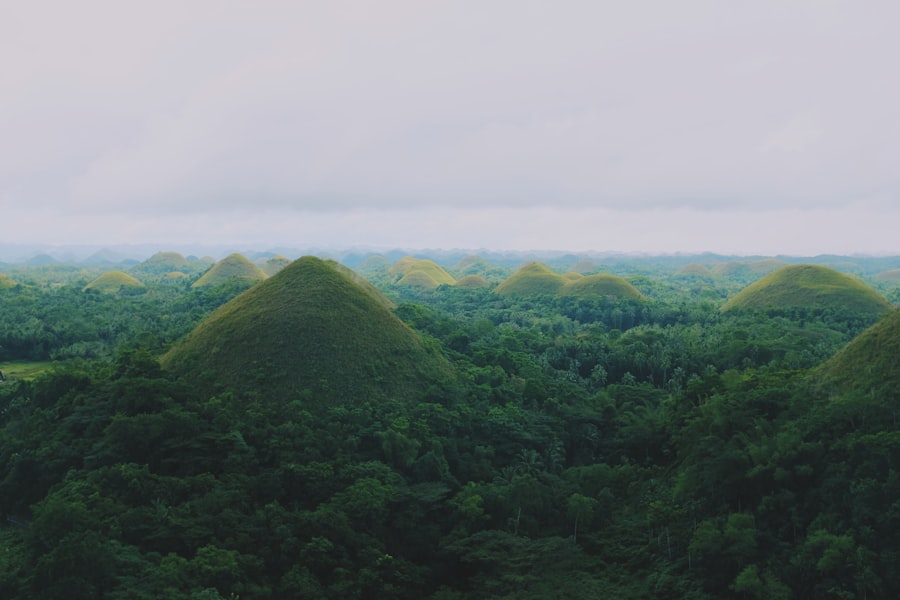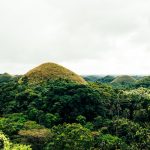Download links
How to install Exploring the Majestic Chocolate Hills of fb777 APK?
1. Tap the downloaded Exploring the Majestic Chocolate Hills of fb777 APK file.
2. Touch install.
3. Follow the steps on the screen.
Description
The Chocolate Hills, a geological wonder located in the Bohol province of the Philippines, are a striking landscape characterized by over 1,200 symmetrical mounds that rise dramatically from the surrounding terrain. These hills, which can reach heights of up to 120 meters, are not actually made of chocolate but are named for their brown hue during the dry season when the grass covering them turns a rich, chocolate color. The formation of these hills is attributed to a combination of geological processes, primarily limestone erosion and the uplift of coral deposits.
The region was once submerged underwater, and over millions of years, the accumulation of marine organisms contributed to the formation of limestone. As tectonic activity raised the land above sea level, the limestone was exposed to the elements. The process of erosion played a crucial role in shaping the Chocolate Hills.
Rainwater, which is slightly acidic due to dissolved carbon dioxide, seeps into the ground and reacts with the limestone, gradually dissolving it. This chemical weathering leads to the formation of sinkholes and other karst features. Over time, the landscape evolved into the iconic conical hills we see today.
The unique topography is further enhanced by the region’s tropical climate, which contributes to the lush vegetation that covers the hills during the rainy season. The interplay between geological forces and climatic conditions has resulted in a landscape that is not only visually stunning but also scientifically significant, offering insights into the Earth’s geological history.
Key Takeaways
- The Chocolate Hills are a unique geological formation consisting of over 1,200 cone-shaped hills, formed from the uplift of coral deposits and subsequent erosion.
- The area surrounding the Chocolate Hills is home to a diverse range of flora and fauna, including various species of plants, birds, and mammals.
- The Chocolate Hills hold cultural significance for the local community and are the subject of several legends, including one about two feuding giants hurling rocks at each other.
- Visitors to the Chocolate Hills can enjoy activities such as hiking, bird watching, and exploring nearby attractions like the Tarsier Conservation Area.
- Conservation efforts are underway to protect the natural beauty of the Chocolate Hills and minimize the environmental impact of tourism, including waste management and reforestation initiatives.
- When planning a visit to the Chocolate Hills, consider the best time to visit, transportation options, and nearby accommodations and attractions.
Flora and Fauna of the Chocolate Hills
Unique Flora
During the wet season, the hills are blanketed with vibrant green grass and wildflowers, creating a stunning contrast against the blue sky. Grasses like cogon grass (Imperata cylindrica) dominate the landscape, while various flowering plants add splashes of color. The flora has adapted to withstand periods of drought and heavy rainfall, showcasing nature’s resilience.
Diverse Fauna
The fauna of the Chocolate Hills is equally diverse, with numerous species inhabiting the area. Birds like the Philippine tarsier, one of the world’s smallest primates, can be spotted among the trees and shrubs. These nocturnal creatures are known for their large eyes and distinctive appearance.
Ecological Significance and Conservation
Other wildlife includes various reptiles and insects that play essential roles in maintaining the ecosystem’s balance. The hills also serve as a habitat for several bird species, making it a popular destination for birdwatchers. The rich biodiversity not only enhances the natural beauty of the Chocolate Hills but also underscores the importance of conservation efforts to protect these unique ecosystems.
Cultural Significance and Legends Surrounding the Chocolate Hills

The Chocolate Hills hold a special place in Filipino culture and folklore, with numerous legends explaining their origin. One popular tale tells of two giants who engaged in a fierce battle, hurling boulders at each other until they grew tired and decided to bury their weapons. The remnants of their conflict transformed into the hills we see today.
This story reflects the rich oral traditions of the local communities and highlights how natural formations can become intertwined with cultural narratives. In addition to legends, the Chocolate Hills are significant in local customs and traditions. They are often featured in festivals and celebrations, symbolizing unity and resilience among the people of Bohol.
The hills have become an emblematic representation of Bohol’s natural beauty and cultural heritage, attracting both locals and tourists alike. The integration of these geological formations into local identity emphasizes their importance beyond mere aesthetics; they serve as a reminder of the region’s history and cultural richness.
Activities and Attractions for Visitors
| Activity/Attraction | Location | Opening Hours | Admission Fee |
|---|---|---|---|
| City Tour | Downtown | 9am – 5pm | 20 |
| Museum Visit | Art District | 10am – 6pm | 15 |
| Zoo Exploration | Outskirts | 9:30am – 4:30pm | 25 |
| Theme Park | Suburb | 11am – 8pm | 40 |
Visitors to the Chocolate Hills can engage in a variety of activities that allow them to fully appreciate this natural wonder. One of the most popular attractions is the viewing platform located at Hill 555, which offers panoramic views of the surrounding landscape. From this vantage point, visitors can take in the breathtaking sight of rolling hills stretching as far as the eye can see, particularly stunning during sunrise or sunset when the colors shift dramatically.
For those seeking adventure, hiking trails around the hills provide opportunities for exploration and physical activity. Guided tours often include visits to nearby attractions such as the Butterfly Conservation Center and local villages where visitors can experience traditional Filipino culture firsthand. Additionally, ATV rides through the rugged terrain offer an exhilarating way to navigate the area while enjoying its natural beauty.
The combination of outdoor activities and cultural experiences makes a visit to the Chocolate Hills a multifaceted adventure that appeals to a wide range of interests.
Conservation Efforts and Environmental Impact
As tourism continues to grow in popularity at the Chocolate Hills, conservation efforts have become increasingly important to protect this unique landscape from environmental degradation. Local government initiatives aim to balance tourism development with ecological preservation. Measures include establishing protected areas around the hills to limit construction and promote sustainable practices among local businesses.
Educational programs are also being implemented to raise awareness about environmental conservation among both residents and visitors. The impact of tourism on the environment cannot be overlooked; increased foot traffic can lead to soil erosion and damage to vegetation if not managed properly. To mitigate these effects, designated pathways have been established to guide visitors while minimizing their impact on sensitive areas.
Furthermore, community involvement in conservation efforts has proven effective in fostering a sense of stewardship among locals, ensuring that future generations can enjoy the beauty of the Chocolate Hills while preserving their ecological integrity.
How to Plan Your Visit to the Chocolate Hills

Planning a visit to the Chocolate Hills requires some consideration to ensure an enjoyable experience. The best time to visit is during the dry season, typically from November to May when the grass turns brown, enhancing their chocolate-like appearance. Travelers can reach Bohol via direct flights to Tagbilaran City or by ferry from Cebu City.
Once in Bohol, various transportation options are available, including rental cars, motorbikes, or guided tours that provide convenient access to key attractions. Accommodations range from budget-friendly hostels to more luxurious resorts, catering to different preferences and budgets. It is advisable to book accommodations in advance during peak tourist seasons to secure availability.
Additionally, visitors should consider hiring local guides who can provide valuable insights into both the geological significance and cultural context of the Chocolate Hills. Engaging with local communities not only enriches the experience but also supports sustainable tourism practices that benefit both visitors and residents alike. In summary, a visit to the Chocolate Hills offers an opportunity to explore one of nature’s most captivating landscapes while immersing oneself in local culture and history.
With careful planning and respect for the environment, travelers can enjoy this UNESCO World Heritage Site while contributing to its preservation for future generations.
If you’re a fan of exploring unique landscapes like the Chocolate Hills in the Philippines, you may also enjoy reading about the popular mobile game Pokemon Go. This game encourages players to get out and explore their surroundings in search of virtual creatures. Check out this article to learn more about how Pokemon Go has revolutionized the way we interact with our environment.
FAQs
What are the Chocolate Hills?
The Chocolate Hills are a geological formation in the Bohol province of the Philippines. They are made up of around 1,268 cone-shaped hills, which are covered in green grass that turns brown during the dry season, giving them the appearance of chocolate kisses.
How were the Chocolate Hills formed?
The exact formation process of the Chocolate Hills is still a subject of debate among geologists. However, it is widely believed that they are the result of the uplift of coral deposits and the action of rainwater and erosion over millions of years.
What is the best time to visit the Chocolate Hills?
The best time to visit the Chocolate Hills is during the dry season, which typically runs from late November to May. This is when the grass covering the hills turns brown, giving them their chocolate-like appearance.
Are there any activities to do at the Chocolate Hills?
Visitors to the Chocolate Hills can enjoy activities such as hiking, bird watching, and taking in the panoramic views from the viewing deck. There are also ATV tours and zip-lining options available for those seeking a more adventurous experience.
Is there an entrance fee to visit the Chocolate Hills?
Yes, there is an entrance fee to visit the Chocolate Hills. The fee helps with the maintenance and preservation of the area.





